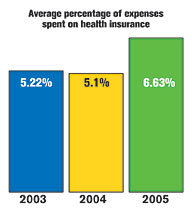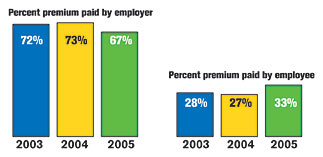
"When I compare my current financials with ones from 15 years ago, my health insurance has taken a large piece of our profits," said Snyder. "My third largest expense is insurance - both business and medical - after materials and labor. We need to address this cost so we can provide better programs for our employees and families."
If you feel the same, Snyder is encouraging those attending this year's Air Conditioning Contractors of America (ACCA) Conference and Indoor Air Expo in San Jose, Calif., to participate in a scheduled roundtable discussion on the subject, "Searching For Answers to the High Cost of Health Care." Snyder, along with fellow ACCA government relations committee members Chris Colditz (Laco Mechanical Services, Palatine, Ill.), Bruce Silverman (Airite Air Conditioning Inc., Tampa, Fla.), and Jeffrey Miller (Al-Don Service Inc., St. Louis), plan to address this ever-growing business concern.
"If we want to make a difference, if we want to attract talented people to this industry, we need to address the injustices that constructively place us at a disadvantage," said Snyder, who believes it is time that contractors unite. "One answer is simple; the application of the answer is difficult. We need to change legislation to allow association health plans (AHPs), giving ACCA and other associations the ability to shop health insurance as a national group." (See the sidebar below.)

TIME TO FIGHT
No doubt about it, health insurance costs "have affected us dearly," admitted Miller."It has increased an average of 18 percent each of the last four years. Between the rising cost of health insurance and fuel cost for the trucks, our costs are becoming virtually impossible to control. We cannot raise our cost to the consumers fast enough.
"We have always tried to cover the cost of health insurance to the employees 100 percent, but we are now having to explore other options," he said.
When her renewal notice arrived in the mail, Colditz was surprised that it increased 21 percent, even though her company did not have any significant claims.
"The year before, it was an 18 percent increase. Once again, we are shopping for another carrier," she said, adding without hesitation, "I am very concerned. The past five years have been very difficult. While gas prices are very high, Chicago just experienced the third warmest January in 100 years. Subzero temperatures are limited to hours, not days. So, every dollar counts and health costs just keep rising."
In Silverman's estimation, it's time to go to battle.
"Combat is a great word to describe the health care market," he said. "It really has been like a war these past few years, and I'm not sure we've really come to grips with who is the enemy. As a relatively small employer, we are only given slivers of information at the time of our health insurance renewal and that usually requires us to troll for meaningful information.
"At our February health insurance renewal, we found out that one of our employees had a child that had accumulated over $100,000 in benefits paid. We knew nothing about this claim until our renewal and were quite surprised at the amount."

SURVEY SAYS
If there is an ever-so-slight ray of hope, it is contained in ACCA's "2005 HVACR Contractor Health Insurance Benefits Analysis," released in late January of this year. The 2005 survey employed fairly similar questions to those that were posed to members in previous years. This survey not only highlights and discusses these current responses, but also contrasts and compares them to the previous results. A total of 266 responses were received, contrasted with 210 collected in 2003-2004.In this latest report, 85 percent of the respondents noted an increase in premiums over the previous year. That is a 4 percent to 5 percent dip, for the 2003 and 2004 respondents indicated that approximately 89 percent to 90 percent of those surveyed had increased health insurance premiums since 2002.
"Better news," admitted Paul Stalknecht, ACCA's chief executive, "but hardly better."

"As much as I hate to state this, it is an option of having your employees share in more of the costs," he said. "But this runs counter to our efforts of attracting talent to the HVACR industry."
Looking at the survey's silver lining, there was a slight increase - from 10 percent in 2004 to 15 percent in 2005 - in contractors increasing health insurance benefits for employees. This could mean providing health insurance for the first time, expanding the coverage or programs offered, decreasing percentage costs of participation, or any other move interpreted as expanding employee benefits.

RATHER SWITCH THAN FIGHT
Contractors were also asked if they changed health care providers and, if so, why. Not surprisingly, 25 percent of the 253 that responded to that particular question stated that they switched and did so specifically to counter rising health care costs. Other contractors changed providers to increase benefits offered and seek out additional positive changes to existing health care plans.At least more employees (75 percent in 2005, as opposed to 74 percent in 2004) are participating in insurance plans offered by their employers. Breaking that down, 49 percent of the respondents paid for the premiums of the employee-only plans, while 47 percent paid the premiums for plans covering an employee, spouse, and children. In the big picture, 42 percent of the respondents stated that they paid for all of the benefits offered to employees, while 58 percent reported that they did not.
Survey participants were also asked to tell ACCA just how much of their health insurance premium costs were borne by their companies and, correspondingly, how much of the balance is paid by participating employees. In 2004, the employer paid 73 percent of premiums, while the employee paid 27 percent of premiums. In 2005, employers paid 67 percent of premiums while the employee paid 33 percent.

This increase in expense toward premiums out of the overall employers' expenses can likely be attributed to a couple of factors, including data showing that employers are slightly less likely to decrease the coverage options previously given to employees due to the overall increased health insurance costs, as well as additional data showing that employers are paying a greater percentage of their employees' premiums while at the same time shopping around for cheaper policies with similar or better benefits packages.
BOTTOM LINE
Overall, respondents continued to experience an increase in their premium costs for the year 2005, but these ever-increasing costs appear to have slowed down, at least to a minimal degree. On the other hand, since employment numbers have remained comparatively stable, companies appear to have adjusted their businesses to accommodate the continued rise in health care costs, including some decreased benefits and, as indicated above, a fairly strong move towards finding coverage elsewhere. An average of 50 percent report decreasing benefits over the previous year, and a slightly higher average of 15 percent showed increases in benefits offered over previous years.
The real difference in these responses lies within geographic regions and between companies of varying sizes. The most interesting detail is the significant decrease in coverage in the Mountain states (consisting of Alaska, Kansas, North Dakota, Nebraska, and South Dakota). These states reported dropping from 100 percent to 67 percent in offering health insurance benefits.
The bottom line: Health care costs continue to rise and continue to affect contracting companies along their bottom lines. Further, the sheer number of respondents changing health care providers in the past year is telling. Based upon employer respondents surveyed and general responses received, the impetus behind switching providers was an attempt to keep health care costs down and under control while seeking to offer employers comparable health care coverage. It is readily evident that rising health care costs have had an impact on participants surveyed by statistics showing decreased participation in some categories and lesser benefits offered in others.
While there are some signs of a general slowing down in this area, costs continue to rise overall, even if not as dramatically as in ACCA's surveys from previous years.

CHALLENGE CONTINUES
In other words, offering good coverage, while keeping costs down, continues to be a huge challenge to contractors."My advice would be to ask questions, do your homework, and be open minded to new ideas," offered Miller. "With health-savings plans and many other new plans developing, there are many avenues to pursue. One needs to understand what you and your employees' needs are. Also understand what your competition is offering their employees."
Remember, said Miller, the insurance industry, in his estimation, "is purposely confusing and deceitful."
"Try to simplify and compare apples to apples when shopping for insurance," he said. "When you are dealing with an existing insurance company, they purposely do not send you renewal information until the last minute, hoping you do not have enough time to shop around. So, be on your toes and knowledgeable, so they know you have a close eye on them."
In his estimation, one has to look at raising deductibles, reducing coverage, and implementing cost-sharing measures with employees. "We raised our deductibles from $250 to $1,000," he said. "Also, we have had to adjust the co-pays for office visits and prescriptions."
Colditz is in the same boat, in that, "We are raising our deductibles to ridiculous amounts."
"The burden on the employee is huge, and we feel like our hands are tied," she said. "We pay for the employee's portion and negotiate the family portion."
In the end, her company is looking into health saving plans and trying to educate the employees to make them more aware of rising costs. "And, we keep shopping health insurance. That becomes more difficult because it seems that some insurance companies are narrowing the doctors and benefits within their programs. Quality care at a reasonable price is be-coming more difficult to find."
The session "The Contractor Health Insurance Roundtable: Searching for Answers to the High Cost of Health Care" will be held 3 p.m. to 4:15 p.m. on Tuesday, March 28, at ACCA's convention in San Jose, Calif. For more information concerning the convention or to register, go to www.indoorairexpo.com.To purchase ACCA's "2005 HVACR Contractor Health Insurance Benefit Analysis," go to www.acca.org/biz/datatools.

Sidebar: Our United Voices
There is strength in numbers. So believes Skip Snyder. Therefore, if contractors want health care costs to lower, the owner of Snyder Company Inc., Upper Darby, Pa., believes it's time contractors unite to get this accomplished."If we want to make a difference, if we want to attract talented people to this industry, we need to address the injustices that constructively place us at a disadvantage," he said. "To change this to an advantage, we need to take this issue personally to our legislators in both personal notes and visits. Our united voices will make a difference."
In Snyder's eyes, it's time that members of Air Conditioning Contractors of America (ACCA) - as well as other contractor groups - stand up to be counted.
"My first message to the HVACR contractor is this: Your voice and vote count, especially when it's united with other ACCA members."
There isn't a lack of talent in the industry, he charged. Instead, he sees a lack of involvement by many in the industry.
"I constantly see the same people attempting to motivate those who don't participate," he said. "What I've learned over the years is to work with those who want to make change and engage in the process."
PERSONAL EXPERIENCE
ACCA president and CEO Paul Stalknecht said there is a valid reason why the association surveys its members each year regarding health care costs. It is designed to bolster the association's arguments on Capitol Hill in support of the Bush administration's plan for association health plans (AHPs).
"ACCA continues to fight for fairness in the nation's health insurance system," he said. "We are still working to convince Congress to give small, community-based businesses, like HVACR contractors, the right to join together in association health plans, and save money through volume, just like Fortune 500 companies and unions do."
To prove that strength is in numbers, Snyder talked about his personal "eminent domain" battle in the state of Pennsylvania.
"As a prudent business owner, I've been investing for retirement by purchasing prime real estate along the main line, just outside of Philadelphia. In February 2004, we were notified that the local township was going to use eminent domain to take the majority of our prime investment property at a discounted value and tender it to another investor. It's called eminent domain for private gain. In 2005, the Supreme Court of the United States also decided to allow this horrific loss of personal rights to property.
"From the very beginning, I was told by many, including friends, attorneys who practice this type of law, and others that I didn't have a chance of stopping this taking of private property. But you know what? I joined with other property owners, business owners, and residents, and we voted in commissioners who were against this abusive tactic. The power of one voice joined by others does work."
Just as important is contributing to the ACCA Political Action Committee (PAC) Fund, said Snyder.
"ACCA represents the HVACR contractor on Capitol Hill, but we need your support. If your time is limited, write letters and contribute to the PAC fund. We can make a difference."
ON THE SAME PAGE
Fellow ACCA Government Relations Committee members Chris Colditz, Jeffrey Miller, and Bruce Silverman are in Snyder's and ACCA's corner.
"I hope there will be a commitment to support the Small Business Health Fairness Act," said Colditz, of Laco Mechanical Services, Palatine, Ill. "I always keep the slogan ‘Decisions are made by those who show up' in front of me."
In her estimation, conquering the high costs of health care requires a three-prong attack:
1. Join an association that is actively supporting the Small Business Health Fairness Act;
2. Get to know your federal legislators and talk to them about this issue and how important it is to the contractor; and
3. Financially support the association through its PAC fund.
"Legislators are very smart," she said. "If an association says it has a large membership, but when a tiny donation of PAC funds is made, that legislator knows the true size of the association."
Colditz has often heard contractors say, "I don't get involved. It is not my game."
"My answer is to ask about past legislation issues. Are you really happy with 13 SEER? Or, would you have been happier with 12 SEER? What if each contractor had spoken to their federal legislators and given the benefits of 12 SEER? Instead, we left the battle to the manufacturers.
"We don't know our own power - and I believe we have huge power. We are the ones who employ a large work force and are in every community, large or small, in this country. Very few businesses can say that."
Contractors must realize that the health care system, as it stands, has been out of control for many years, added Silverman, of Airite Air Conditioning Inc., Tampa, Fla.
"It is incumbent that all contractors join coalitions pushing our legislators for meaningful health care reform. ACCA is one of many organizations in the forefront pushing for affordable health care."
Contractors' hope for health care's future revolve around contractors' ability to influence Congress to let AHPs "be our plan of choice," he said.
"The ability to contain costs through this type of plan would put us on an even footing with large corporations in our quest for employees and cost savings. During our annual lobbying effort with members of Congress, AHPs are always our first topic of conversation. I believe this effort has to be intensified and strong coalitions formed in the construction industry in order to bring our health costs and benefits in line with those of multinational corporations.
"The main issue in getting this legislation passed seems to be the individual states' department of insurance. To allow AHPs to exist, the states would be giving up some control and most likely some lucrative campaign dollars furnished by local health insurance providers."
Publication date: 03/13/2006

Report Abusive Comment